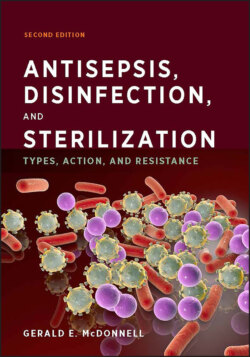Читать книгу Antisepsis, Disinfection, and Sterilization - Gerald E. McDonnell - Страница 36
1.4.4 Choosing a Process or Product
ОглавлениеAt least three factors should be considered in the choice of a biocidal process or product for a given application: antimicrobial efficacy, safety, and compatibility. For antimicrobial efficacy, the requirements and choice of biocide for a preservation application (generally bacteriostatic and fungistatic activity) vary from that of a sterilization process which should render a product sterile and free from microbial contamination. The spectrum of antimicrobial activities for various physical and chemical biocides are considered further in chapters 2 to 6. The choice of biocidal treatment will often depend on the risk associated with the level and type of contamination on the surface or in a given product. An example is the Spaulding classification for reusable medical devices, which defines them as critical, semicritical, or noncritical based on the risk of infection with the presence of contamination. Critical devices demonstrate the greatest risk because they are introduced directly into the human body, with contact with the bloodstream or other normally sterile areas of the body; due to the risks associated with contamination, it is recommended that critical devices be sterilized. Semi critical devices present a lower risk, as they may contact intact mucous membranes or nonintact skin during use, and therefore a minimum requirement for high-level disinfection is recommended. High-level disinfectants are considered effective against all microbial pathogens, with the exception of large numbers of bacterial spores. Finally, noncritical devices present the lowest risk of transmission of infection, i.e., they contact intact skin only, and at a minimum should be reprocessed with intermediate- or low-level disinfectants. A similar risk assessment can be used in the choice of any antiseptic, disinfectant, or sterilization process for a given application.
Safety aspects include hazards in the use of the product, residues that remain on or in a treated product following application, environmental concerns, and reactivity on mixing with other agents. For this reason, biocides and biocidal products are usually provided with safety data sheets (e.g., material safety data sheets) that contain information regarding ingredients, hazards, first aid measures, personnel protection, stability and reactivity, toxicology, and ecological (e.g., bioaccumulation) concerns. For automated processes, these details should also be provided in equipment manuals and are often specified in various guidelines and standards. These safety aspects should be reviewed and considered prior to the use of a biocidal product or process. In many countries, the specific use of certain biocides may be restricted due to health and environmental concerns.
Finally, compatibility with the surface or product is important to ensure that unexpected damage does not occur. Compatibility may be defined as the suitability of a biocidal product or process to be used on a surface or in a solution without causing unacceptable interactions, damage, or other undesirable effects. It is for this reason that a restricted number of biocides are used on foods or on the skin (as antiseptics) (see chapter 4). A wider range of biocides are used on hard surfaces, but they also vary in compatibility (e.g., some heat-based processes cannot be used for temperature-sensitive surfaces or products). Other considerations will depend on the specific application and include reproducibility, ease of use, cycle or application time, cost, guidelines and standards (which are further considered in section 1.4.5), and specific regulatory requirements.
